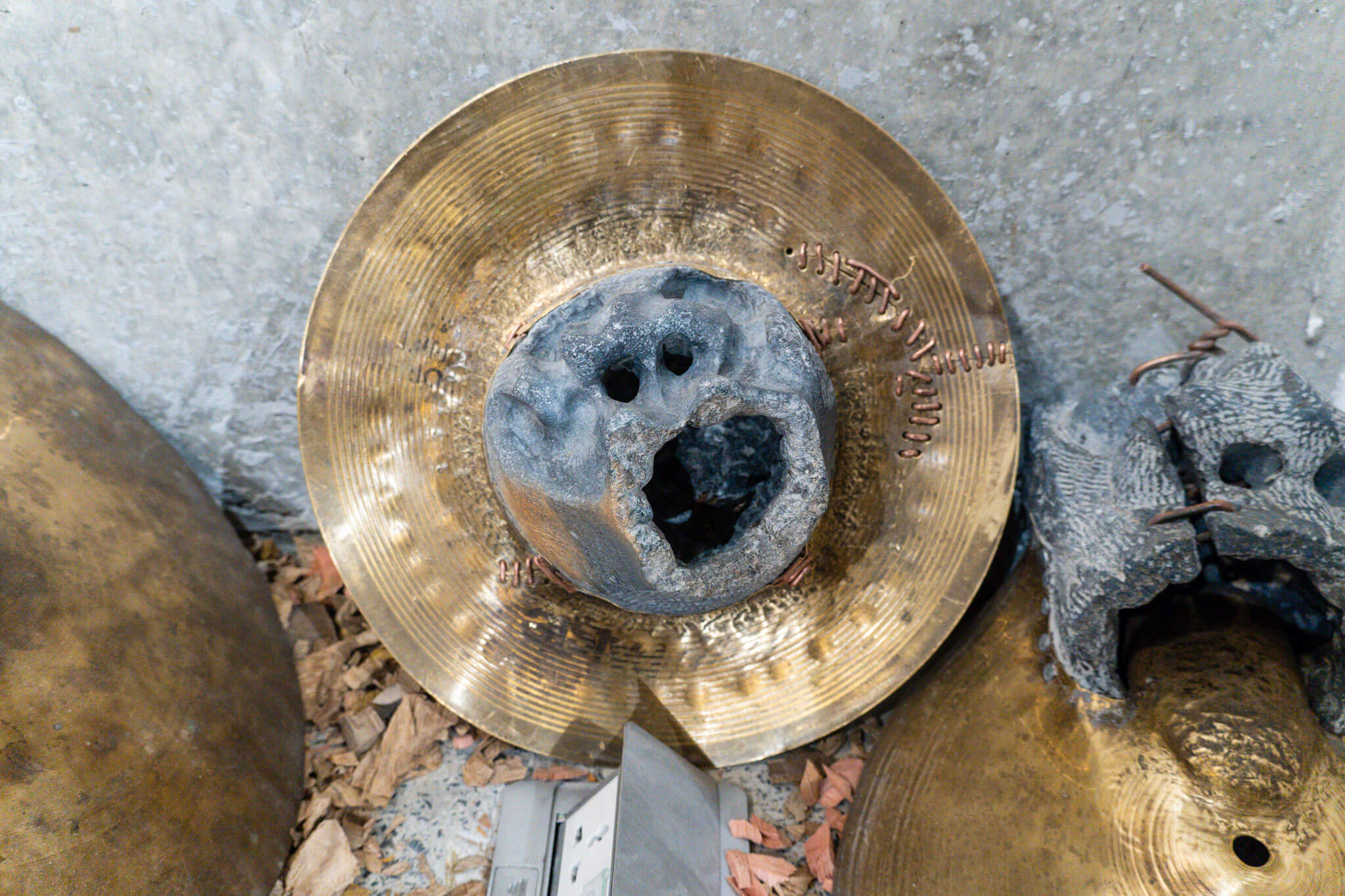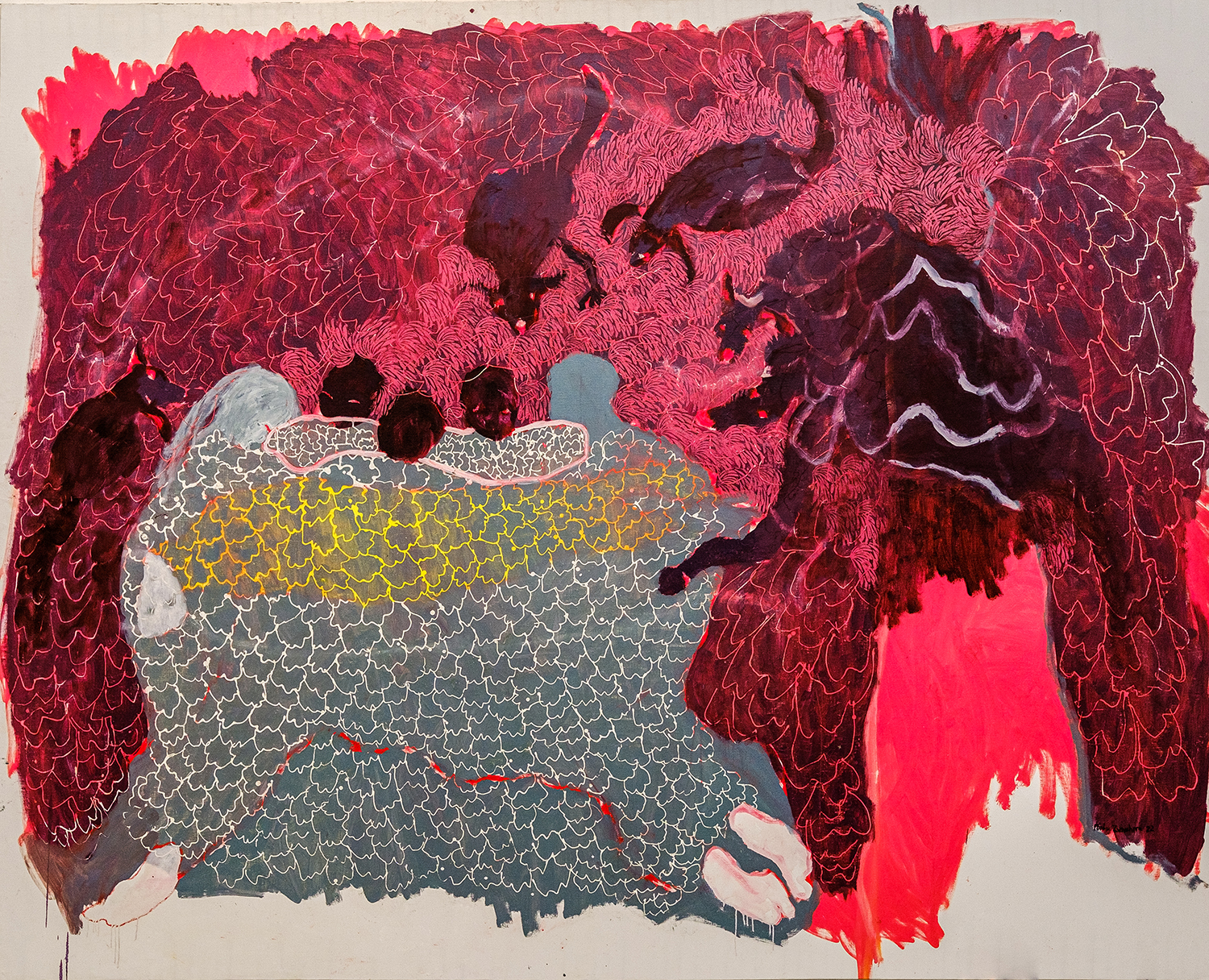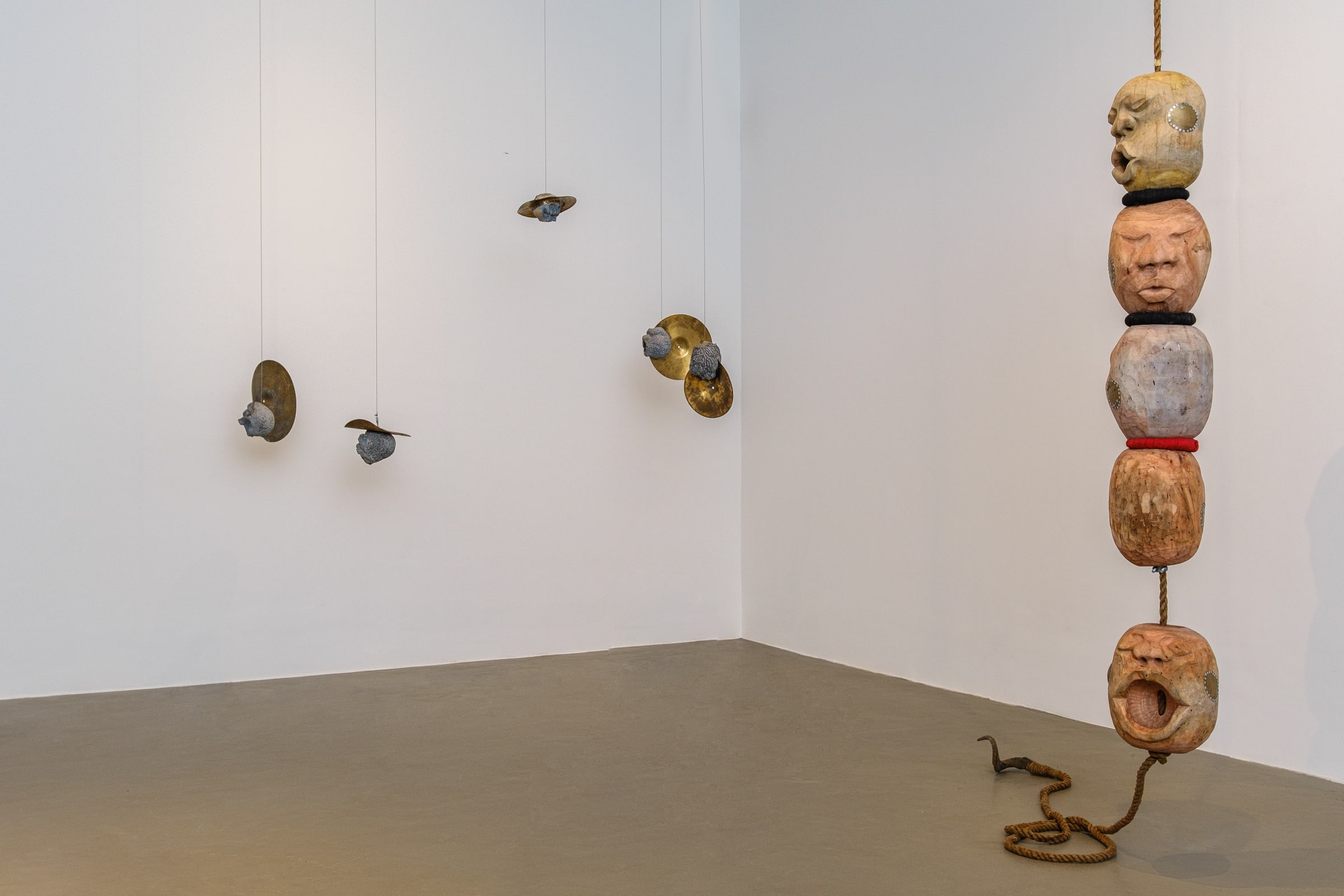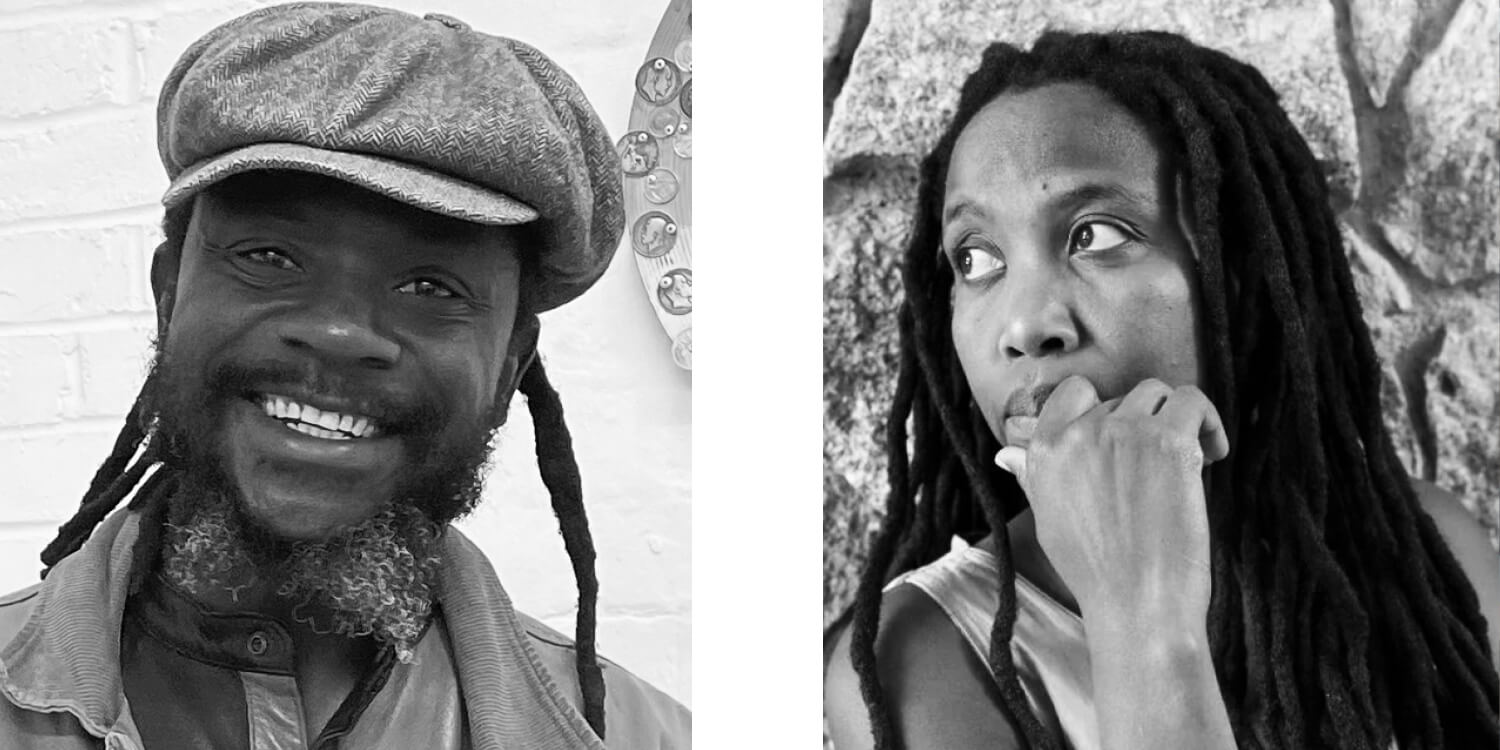Earlier this month saw the opening of I See You, a group exhibition of new and recent works at Tiwani Contemporary by Virginia Chihota, Gideon Gomo, Masimba Hwati, Gareth Nyandoro and Portia Zvavahera. Though the participating artists are now based across Africa and Europe, they share a connection that was established in their formative years during their studies at the National Gallery School of Visual Arts and Design (formerly B.A.T. Visual Arts School) in Harare, Zimbabwe. Several decades on they have actively maintained a close relationship, a celebration of which forms the central thread that runs through this ‘first of its kind’ survey in Nigeria.
Prior to the exhibition’s launch, and as part of an ongoing collaboration with G.A.S. Foundation, Tiwani Contemporary invited participating sculptor Gideon Gomo and painter printmaker Portia Zvavahera to engage in a residency at our Lagos building. It was an opportunity for both to transpose their practices to a new intercontinental context and explore the implications that such an exchange might have on their work. Following on from the residency, we spoke to both Gomo and Zvavahera about their experience of the process.

Process photo taken during Gideon Gomo's time working in the G.A.S. studio space.
What is the current focus of your practice?
Gideon Gomo: At the moment I’m preoccupied with emotions, and specifically uncovering emotions that we, as men, don’t normally show because we’ve been told not to feel and express them. I’m an African and these spiritual battles, as I see them, are something that is a constant reality in my country of Zimbabwe. Men in particular have been told not to cry so they’ve invented new ways to cry - some people drink and others drive for example.
I’ve been working on a series of pieces that lay bare that feeling of fighting something that is not seen. It’s been a process of learning to discern and visually articulate emotions which are often not recognised as tangible unless they are expressed. How do you show someone who is depressed for example? I’m trying to convey to people that we have these complex emotions and we feel them.
I’m not so concerned with my ability to carve these works, for me the most important thing is being able to tell a story and narrative. The works have to be able to speak even when I’m not there, and they should be able to invoke that human and emotional element.
Portia Zvavahera: I have one primary theme in my work; I’m always looking at my dreams and interpreting them. In many ways, the work I’m producing here in Lagos is a continuation of where I left off when I was working in my studio at home in Harare.
The figures, visions and emotions that come to me while I’m sleeping are frequently expressed in what I produce as an artist. Sometimes I’m able to uncover who is being manifested, but at other times it remains a mystery. Recently, for example, I’ve been dreaming of a Black woman with wings surrounded by mice and elements of that are what you see expressed in these canvases.

Portia Zvavahera, Rangani (devise your strategy), 2022. Oil-based printing ink and oil bar on Linen. Image: Courtesy of the artist, Stevenson, and David Zwirner
What drew you to this particular residency?
GG: I felt like I needed this residency because at home there is no time frame within which to produce, I needed that rush and Lagos has really provided it. I wanted to create something from within this city that spoke both to the people here and where I come from.
The studio at G.A.S. is nice and new and I like the idea of the Foundation being an artist-led space that is at the very start of its journey. We’ve been encouraged to share our ideas about how to evolve it and it feels like we’re all working together to help build something.
PZ: After being invited to take part in the show at Tiwani Contemporary I heard about G.A.S. and asked them whether it would be possible to participate in the residency programme. I was feeling stuck at home and wanted to make work in a new environment as a way of finding inspiration.

Gideon Gomo, Ko Ini Ndisinawo Hata, 2022. Spring stone, brass cymbals, metal wire and rivets and Chiwono Chemukati, 2022. Mahogany and cedar wood, brass plates, manilla rope, ram horns, and Hata/cloth Headgear. Image: Courtesy of the artist and Tiwani Contemporary
How did you end up using the residency period?
GG: I mainly worked on developing ideas for the exhibition at Tiwani Contemporary. For me, the residency was very empowering and working away from home often felt like a marathon. I feel like I’ve broken my own record both in terms of the physical and mental body of work that I was able to create in such a short space of time. It was a challenge that I really welcomed. In Nigeria they have everything but if you don’t know how to get it it can be very stressful and that experience has been interesting to me.
PZ: Because of the time constraint, I mainly used the period to produce new work for the exhibition, working on several pieces simultaneously. I tried to take the energy that comes with the space and the city, and channel that into my work. We also found some time to visit some interesting cultural sites in and around Lagos like the Ikotun synagogue (The Synagogue Church of All Nations) and Nike Art Gallery.
Filmed and edited by Yinka Babalola. Video courtesy of the Artist and Tiwani Contemporary.
RESIDENCY ARCHIVE
EVENT: An Unfolding Prelude
Event Date: 6th November 2022
Our second and third Tiwani Contemporary residents; painter/printmaker Portia Zavavahera and sculptor Gideon Gomo. They made full use of the multifunctional studio/gallery space to make large-scale ambitious work for I See You which opened at Tiwani Contemporary, Lagos in early November. The group exhibition, I See You featured new and recent works by artists Gideon Gomo, Portia Zvavahera, Masimba Hwati, Gareth Nyandoro and Virginia Chihota.
The artists studied at the National Gallery School of Visual Arts and Design (formerly B.A.T. Visual Arts School), National Gallery of Zimbabwe during the 1990s in Harare. Spanning painting, sculpture, performance and drawing, the exhibition captures how each artist internalises and responds to the notion of environment.
 Exhibition view, I See You, 2022. Image courtesy of Tiwani Contemporary.
Exhibition view, I See You, 2022. Image courtesy of Tiwani Contemporary.
ABOUT GIDEON GOMO AND PORTIA ZVAVAHERA
GIDEON GOMO (b. 1983) is a visual artists and sculptor based in Harare, Zimbabwe. He studied at the National Gallery Visual Arts Studios of Zimbabwe and has exhibited extensively internationanlly in Germany, South Africa, Austria and his native Zimbabwe. He has completed both local and international artist residencies in Germany and South Africa and participated in the Oberncation Sculpture Symposium in 2009 and again in 2012. His practice has always focused on everyday life and his lived experience, Gomo's current preoccupation is the exploration of emotions, and specifically uncovering emotions that men don’t typically express due to social and societal constraintaints and expectations.
PORTIA ZVAVAHERA was born in 1985 in Harare where she currently lives and works. She studied at the BAT Visual Arts Studio under the auspices of the National Gallery of Zimbabwe between 2003 and 2005, after which she obtained a Diploma in Visual Arts from Harare Polytechnic in 2006. She has had six solo exhibitions at Stevenson Cape Town and Johannesburg (2014-20), and two at David Zwirner, London and New York (2020–21). The Institute of Contemporary Art Indian Ocean in Mauritius presented a small survey, Walk of Life, in 2020. A two-person show, Portia Zvavahera and Gustav Klimt: A Dialogue, took place at De 11 Lijnen, Oudenburg, in 2019. Zvavahera held a solo exhibition, Under My Skin, at the National Gallery of Zimbabwe, Harare, in 2010. Zvavahera featured in the main exhibition of the 59th Venice Biennale, The Milk of Dreams. She represented Zimbabwe at the 55th Venice Biennale in 2013 as part of the exhibition Dudziro: Interrogating the Visions of Religious Beliefs at the Zimbabwean Pavilion.
 Gideon and Portia's residency is generously supported by Tiwani Contemporary.
Gideon and Portia's residency is generously supported by Tiwani Contemporary.
